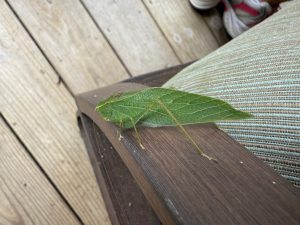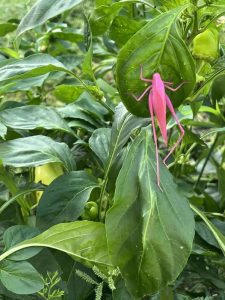
A typical katydid, with remarkable leaf-like camouflage. Photo credit: Carrie Stevenson, UF IFAS Extension
The intricate camouflage developed within the animal kingdom never fails to fascinate me. From fish that look like seagrass blades to butterflies that look like tree bark—or a pair of eyes—the variety, color, and textures are just mind-boggling. Among those are the leaf bugs, or katydids, that flawlessly evoke natural foliage. I had one join me on a patio chair recently, and I couldn’t stop starting at the detailed venation on their wings, which perfectly mimicked the veins on a leaf.

One of the pink katydids on display at the Audubon Insectarium. Photo credit: Amy Pitre courtesy LSU AgCenter
There are well over 6,000 species of katydids, and they’re found on every continent but Antarctica. Related to crickets and grasshoppers, they are similar in that they are remarkable jumpers, with strong hind legs that can also produce recognizable scraping, buzzing, and trilling sounds. The insects got their name from the perception that the noises they produce sound like, “Katy did!, Katy didn’t!” which are primarily made by males of the species. Song production and recognition among katydids are highly developed, used for warnings, attracting mates, or defending territory. Katydids detect sounds by raising their front legs, which have sensing/hearing patches called tympanum. Katydid and cicada songs can be differentiated by timing—cicadas trill during the day, while katydids are active at night.
Katydids have antennae nearly as long as their bodies, and despite their large wings are not strong flyers. Every katydid I’ve ever seen is a leafy green color, blending perfectly into its surroundings and hiding in plain sight from avian predators. However, they come in several different colors, including tan, yellow, orange, and hot pink. I cannot fathom how hot pink is an effective adaptation, but they are occasionally found—at a rate of 1 in 500—in the wild. The pink coloration is due to a genetic condition called erythrism, which is similar to the recessive traits causing albinism. New Orleans’ Audubon Insectarium exhibits several pink katydids, which, with no natural predators, can live typical katydid lifespans.
Katydids are found widely in the state and can be a pest of citrus, but are not considered a major issue. In a home garden, they are generally considered beneficial. While they might nibble on plant parts, they also feed on pest insects like aphids and can aid in pollination.
- Yucca–A Tough and Versatile Native Plant - November 26, 2025
- Blazing Star - November 6, 2025
- University of West Florida’s New Heritage Roots Garden - October 17, 2025
